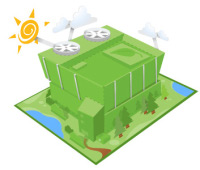 Migration to cloud business solutions may actually benefit the company’s financial and energy capabilities. The energy efficiency of the cloud IT infrastructure was confirmed as the result findings of the 6-month research study from the Lawrence Berkeley National’s Computational Research Development (CRD) Laboratory and the Environmental Energy Technologies (EETD) of the Northwestern’s McCormick School of Engineering and Applied Science were released.
Migration to cloud business solutions may actually benefit the company’s financial and energy capabilities. The energy efficiency of the cloud IT infrastructure was confirmed as the result findings of the 6-month research study from the Lawrence Berkeley National’s Computational Research Development (CRD) Laboratory and the Environmental Energy Technologies (EETD) of the Northwestern’s McCormick School of Engineering and Applied Science were released.
The objective of the Google-funded research was to develop a model that would benefit the public cloud and other researchers in the analysis of the carbon impact and energy use of cloud computing. Among the highlights of the research is the discovery that cloud computing can actually save at least 23 billion kilowatt-hours (kWh) from a minimum of 86 million workers in the United States. The conserved energy can already be used to provide the city of Los Angeles with a one year supply of free electricity.
The other benefits of cloud computing include the creation of a greener computing environment, and the provision of a benchmark model in the calculation of the cloud solution’s impact to an existing organization.
The study focused on the three business methods that would be greatly influenced by cloud computing. This includes the customer relationship management software (CRM), email correspondence, and productivity software such as file sharing, word document and spreadsheet.
The new model developed from the research was named as the Cloud Energy and Emissions Research (CLEER) framework. This fresh model will hopefully encourage other researchers to make a follow up study on the new conceptual framework.
Eric Masanet, Northwestern’s, lead author of the study said, “We can’t fly by the seat of our pants when it comes to assessing sustainability. We need numbers — hard data — to properly analyze how cloud computing compares to how computing is done now. Well-thought-out analysis is especially important with new technology, which can have unforeseen effects. Our public model allows us to look forward and make informed decisions. What we found overall is that by hosting services on the cloud as opposed to locally, the savings are pretty robust.”
For the part of Berkeley Lab’s CRD, Lavanya Ramakrishnan acted as the principal representative for the project. Berkeley Lab was contacted by Google because of the former’s detailed research on data center’s energy efficiency and cloud computing’s sustainability. The findings of the research are currently helping the Department of Energy and its scientists discover the impact of large-scale data centers to the environment.
“We commend Berkeley Lab for completing such a thorough study of the broader implications of Internet computing. We’re especially excited that the model will be made available to other researchers and experts interested in doing their own analysis,” said Michael Terrell, Google Senior Policy Council for Energy and Sustainability.
Ramakrishnan of Berkeley directed the development of the new public model, while Pradeep Mantha and Valerie Hendrix provided the technical support. Arman Shehabi, on the other hand, of Northwestern’s EETD spearheaded the analysis of the model framework and the testing environments applied to it.
What is the CLEER?
CLEER is open source software that analyzes the energy use of a networking hardware, a server, a building system, a client physical computer and all other energy source applied in the manufacture and transport of these cloud computing solutions. CLEER is currently the most sophisticated and comprehensive effort developed that has the potential to quantify and identify the energy savings from the use of cloud computing.
How does it work?
IT administrators or managers can upload information and access the system using any of the three scenarios: CRM software, email and other productivity applications that are currently available. The results can be accessed via Web menus and custom assessment features.
CLEER model hopes to spur a chain of discussion from users and providers on the impact of energy-related facets of cloud computing. These facets include assumptions on the new model analytics, input on the different cloud scenarios, and community perspectives on the data available.
Ramakrishnan added, “The model, which will be available to a wide audience, allows you to evaluate energy use of various options in a significant way. By studying the present day and cloud scenarios, you can see the net energy and carbon-footprint benefits at a range of scales.”
Cloud researchers, however, warned that since Google’s cloud platform is thriving in selling IaaS and various cloud applications, its intention to push the energy benefits of cloud computing is due to obvious reasons.
“In particular, our reliance on publicly available data is a significant source of uncertainties, given that data was drawn from a number of different studies and sources that were published in different years and with differing scopes and regions of analyses,” researchers said.
The same team of researchers from the study is scheduled to tap into the cloud platforms in European countries before the end of this year. For this project, it will be headed by three Northwestern graduate student’s Ben Walker, Jiaqi Liang and Xiahui Ma.